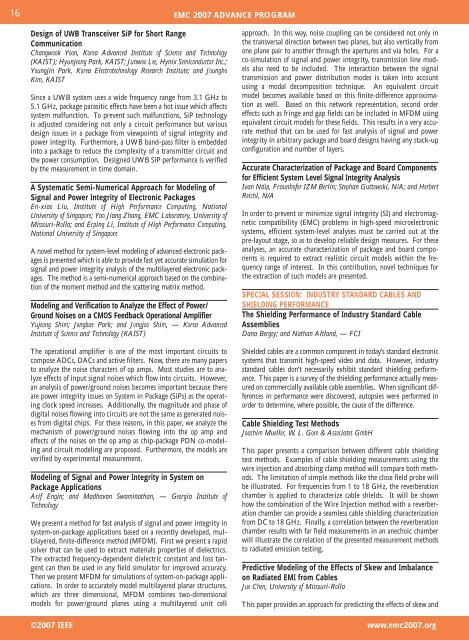2007 ieee international symposium on electromagnetic compatibility
2007 ieee international symposium on electromagnetic compatibility
2007 ieee international symposium on electromagnetic compatibility
You also want an ePaper? Increase the reach of your titles
YUMPU automatically turns print PDFs into web optimized ePapers that Google loves.
16EMC <str<strong>on</strong>g>2007</str<strong>on</strong>g> ADVANCE PROGRAMDesign of UWB Transceiver SiP for Short RangeCommunicati<strong>on</strong>Changwook Yo<strong>on</strong>, Korea Advanced Institute of Science and Technology(KAIST); Hyunje<strong>on</strong>g Park, KAIST; Junwoo Lee, Hynix Semic<strong>on</strong>ductor Inc.;Youngjin Park, Korea Electrotechnology Research Institute; and JounghoKim, KAISTSince a UWB system uses a wide frequency range from 3.1 GHz to5.1 GHz, package parasitic effects have been a hot issue which affectssystem malfuncti<strong>on</strong>. To prevent such malfuncti<strong>on</strong>s, SiP technologyis adjusted c<strong>on</strong>sidering not <strong>on</strong>ly a circuit performance but variousdesign issues in a package from viewpoints of signal integrity andpower integrity. Furthermore, a UWB band-pass filter is embeddedinto a package to reduce the complexity of a transmitter circuit andthe power c<strong>on</strong>sumpti<strong>on</strong>. Designed UWB SiP performance is verifiedby the measurement in time domain.A Systematic Semi-Numerical Approach for Modeling ofSignal and Power Integrity of Electr<strong>on</strong>ic PackagesEn-xiao Liu, Institute of High Performance Computing, Nati<strong>on</strong>alUniversity of Singapore; Yao Jiang Zhang, EMC Laboratory, University ofMissouri-Rolla; and Erping Li, Institute of High Performance Computing,Nati<strong>on</strong>al University of SingaporeA novel method for system-level modeling of advanced electr<strong>on</strong>ic packagesis presented which is able to provide fast yet accurate simulati<strong>on</strong> forsignal and power integrity analysis of the multilayered electr<strong>on</strong>ic packages.The method is a semi-numerical approach based <strong>on</strong> the combinati<strong>on</strong>of the moment method and the scattering matrix method.Modeling and Verificati<strong>on</strong> to Analyze the Effect of Power/Ground Noises <strong>on</strong> a CMOS Feedback Operati<strong>on</strong>al AmplifierYuje<strong>on</strong>g Shim; J<strong>on</strong>gbae Park; and J<strong>on</strong>gjoo Shim, — Korea AdvancedInstitute of Science and Technology (KAIST)The operati<strong>on</strong>al amplifier is <strong>on</strong>e of the most important circuits tocompose ADCs, DACs and active filters. Now, there are many papersto analyze the noise characters of op amps. Most studies are to analyzeeffects of input signal noises which flow into circuits. However,an analysis of power/ground noises becomes important because thereare power integrity issues <strong>on</strong> System in Package (SiPs) as the operatingclock speed increases. Additi<strong>on</strong>ally, the magnitude and phase ofdigital noises flowing into circuits are not the same as generated noisesfrom digital chips. For these reas<strong>on</strong>s, in this paper, we analyze themechanism of power/ground noises flowing into the op amp andeffects of the noises <strong>on</strong> the op amp as chip-package PDN co-modelingand circuit modeling are proposed. Furthermore, the models areverified by experimental measurement.Modeling of Signal and Power Integrity in System <strong>on</strong>Package Applicati<strong>on</strong>sArif Engin; and Madhavan Swaminathan, — Georgia Institute ofTechnologyWe present a method for fast analysis of signal and power integrity insystem-<strong>on</strong>-package applicati<strong>on</strong>s based <strong>on</strong> a recently developed, multilayered,finite-difference method (MFDM). First we present a rapidsolver that can be used to extract materials properties of dielectrics.The extracted frequency-dependent dielectric c<strong>on</strong>stant and loss tangentcan then be used in any field simulator for improved accuracy.Then we present MFDM for simulati<strong>on</strong>s of system-<strong>on</strong>-package applicati<strong>on</strong>s.In order to accurately model multilayered planar structures,which are three dimensi<strong>on</strong>al, MFDM combines two-dimensi<strong>on</strong>almodels for power/ground planes using a multilayered unit cellapproach. In this way, noise coupling can be c<strong>on</strong>sidered not <strong>on</strong>ly inthe transversal directi<strong>on</strong> between two planes, but also vertically from<strong>on</strong>e plane pair to another through the apertures and via holes. For aco-simulati<strong>on</strong> of signal and power integrity, transmissi<strong>on</strong> line modelsalso need to be included. The interacti<strong>on</strong> between the signaltransmissi<strong>on</strong> and power distributi<strong>on</strong> modes is taken into accountusing a modal decompositi<strong>on</strong> technique. An equivalent circuitmodel becomes available based <strong>on</strong> this finite-difference approximati<strong>on</strong>as well. Based <strong>on</strong> this network representati<strong>on</strong>, sec<strong>on</strong>d ordereffects such as fringe and gap fields can be included in MFDM usingequivalent circuit models for these fields. This results in a very accuratemethod that can be used for fast analysis of signal and powerintegrity in arbitrary package and board designs having any stack-upc<strong>on</strong>figurati<strong>on</strong> and number of layers.Accurate Characterizati<strong>on</strong> of Package and Board Comp<strong>on</strong>entsfor Efficient System Level Signal Integrity AnalysisIvan Ndip, Fraunhofer IZM Berlin; Stephan Guttowski, N/A; and HerbertReichl, N/AIn order to prevent or minimize signal integrity (SI) and <strong>electromagnetic</strong><strong>compatibility</strong> (EMC) problems in high-speed microelectr<strong>on</strong>icsystems, efficient system-level analyses must be carried out at thepre-layout stage, so as to develop reliable design measures. For theseanalyses, an accurate characterizati<strong>on</strong> of package and board comp<strong>on</strong>entsis required to extract realistic circuit models within the frequencyrange of interest. In this c<strong>on</strong>tributi<strong>on</strong>, novel techniques forthe extracti<strong>on</strong> of such models are presented.SPECIAL SESSION: INDUSTRY STANDARD CABLES ANDSHIELDING PERFORMANCEThe Shielding Performance of Industry Standard CableAssembliesDana Bergey; and Nathan Altland, — FCIShielded cables are a comm<strong>on</strong> comp<strong>on</strong>ent in today’s standard electr<strong>on</strong>icsystems that transmit high-speed video and data. However, industrystandard cables d<strong>on</strong>’t necessarily exhibit standard shielding performance.This paper is a survey of the shielding performance actually measured<strong>on</strong> commercially available cable assemblies. When significant differencesin performance were discovered, autopsies were performed inorder to determine, where possible, the cause of the difference.Cable Shielding Test MethodsJoachim Mueller, W. L. Gore & Associates GmbHThis paper presents a comparis<strong>on</strong> between different cable shieldingtest methods. Examples of cable shielding measurements using thewire injecti<strong>on</strong> and absorbing clamp method will compare both methods.The limitati<strong>on</strong> of simple methods like the close field probe willbe illustrated. For frequencies from 1 to 18 GHz, the reverberati<strong>on</strong>chamber is applied to characterize cable shields. It will be shownhow the combinati<strong>on</strong> of the Wire Injecti<strong>on</strong> method with a reverberati<strong>on</strong>chamber can provide a seamless cable shielding characterizati<strong>on</strong>from DC to 18 GHz. Finally, a correlati<strong>on</strong> between the reverberati<strong>on</strong>chamber results with far field measurements in an anechoic chamberwill illustrate the correlati<strong>on</strong> of the presented measurement methodsto radiated emissi<strong>on</strong> testing.Predictive Modeling of the Effects of Skew and Imbalance<strong>on</strong> Radiated EMI from CablesJue Chen, University of Missouri-RollaThis paper provides an approach for predicting the effects of skew and©<str<strong>on</strong>g>2007</str<strong>on</strong>g> IEEE www.emc<str<strong>on</strong>g>2007</str<strong>on</strong>g>.org
















